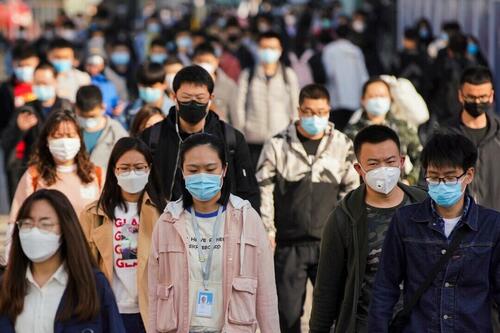China’s CDC Reports New COVID-19 Cases Hit Nearly 20 Percent
Authored by Alex Wu via The Epoch Times,
The Chinese Center for Disease Control and Prevention (CDC) reported that new COVID-19 infections in the country of origin have increased to nearly 20 percent in the past few weeks, as two new Omicron subvariants spread across the country.
But while increases to China’s official COVID-19 test positivity rate mirrors that of the rest of the world, its number of reported COVID-19 deaths remains orders of magnitude lower than is expected for a country of its population, given the ongoing reports of COVID-19-related deaths in other countries.
According to its Aug. 8 report, China’s CDC reported that the COVID-19 test positivity rate in the country spiked to 18.7 percent in the last week of July, up from 8.9 percent at the start of the month. According to the official data, that rate has not exceeded 8 percent since the start of the year.
The trend of China’s official infection data parallels that reported in the United States. The U.S. Centers for Disease Control and Prevention (U.S. CDC), in its Aug. 8 biweekly update, reported that the COVID-19 test positivity rate in the United States had increased in the past six months to 17.6 percent.
According to the World Health Organization’s monitoring data from 84 countries, the overall COVID-19 test positivity rate stands above 10 percent but varies by region. That percentage has been rising for weeks, it said. Europe also reported a 20 percent increase in its positive COVID-19 tests since the start of 2024.
But for the month of July, China’s CDC reported only two deaths from COVID. Meanwhile, the U.S. CDC data reflected significantly more provisional COVID-related deaths, with 1,920 U.S. deaths reported in July citing COVID-19 as an underlying or contributing cause. China also has a much larger population: 1.4 billion to the United States’ 335 million.
China’s ruling Chinese Communist Party (CCP) has long been accused by the international community of downplaying and covering up the true scale of COVID-19 infections and deaths in the country since late 2019, when COVID-19 first broke out in Wuhan, in the country’s Hubei Province.
New Omicron Subvariants
China’s CDC named the XDV and JN.1 Omicron subvariants as the prevalent strains contributing to the 7,042 COVID-19 cases officially recorded in July.
The official Chinese reporting said that Omicron subvariant XDV and its descendants accounted for 38 percent to 43 percent of infections, while Omicron subvariant JN.1 and its descendants—including the subvariants JN.1.7, JN.1.18, KP.2, KP.3, and LB.1—accounted for 55 percent to 60 percent of infections.
U.S. CDC data showed that as of Aug. 8, XDV.1 subvariant of parent strain XDV accounted for only 0.3 percent of cases in the United States—a reduction from previous months. Meanwhile, the KP.3.1.1 variant is now the most common strain in the United States, followed by KP.3, LB.1, KP.2.3, and KP.2—all of which came from the JN.1 parent strain. The U.S. CDC said it saw no evidence that these new variants were causing more severe symptoms.
Dr. Dong Yuhong, an infectious disease specialist and senior medical columnist for The Epoch Times, said on Aug. 9 that the JN.1-derived subvariants “KP.3 and KP.2 have similar virological and epidemiological characteristics” but that their test positivity rate in China has increased.
She noted that the variants have a stronger ability to evade the antibodies that people have developed from past infections or vaccination.
China’s latest vaccine targeted the XBB.1.5 variant, she said, which belongs to a different sublineage of the shared parental BA.2 Omicron variant.
Dong said that while there are again signs of increased COVID-19 transmission, it remains unclear whether a deadly COVID-19 strain that could cause another pandemic could emerge. She added that COVID-19 “requires continuous monitoring and close observation.”
She said that the speed of vaccine development “can’t keep up” with the virus’s continuous mutation and that “simply depending on vaccines is unsafe and unreliable.”
“We have an innate multi-immune barrier in each of us,” she said. “As long as we pay attention to strengthening and protecting it, it will be effective.”
She advised everyone to avoid habits that damage immunity, such as smoking, drinking, and staying up late, and develop more good habits that enhance immunity, such as regular exercise, meditation, and improving our capacity to regulate our emotions.
“That’s a positive approach to dealing with epidemics,” she said.
No Transparency, Trust
After years of controlled releases of approved official data, censorship of whistleblowers, and mandating COVID-19 restrictions and prolonged lockdowns across China, the CCP suddenly reversed course and lifted all its restrictions, testing, and reporting about COVID-19 in 2022. But it continued with its lack of transparency, leaving many Chinese feeling that they are unable to trust their institutions and still in the dark about the true seriousness of the COVID-19 epidemic in the country.
The Chinese regime’s experts estimated that 80 percent of China’s population was infected with COVID-19 at the end of 2022 when its restrictions were lifted.
Recent posts by Chinese doctors on Chinese social media heightened the populace’s fear, with a number saying that a more contagious COVID-19 variant is responsible for China’s new infections.
Hu Yang, a chief physician of the Department of Respiratory and Critical Care at Shanghai Pulmonary Hospital and associate professor at Tongji University, said in a video posted on Chinese social media that with the recent wave of COVID-19 infections, some young people have also been found to be suffering severe infections in their lungs and exhibiting white lung symptoms.
“With the virus causing COVID-19 still mutating, the dominant virus strain [in China] has become XDV, which is more contagious, and many people have been infected again,” Hu said. “At present, XDV mutant strains can still spread in high-temperature environments.”
Feng Ge, a member of the China Association for Research and Development of Traditional Chinese Medicine, wrote on Chinese social media on Aug. 4 that “currently, there are two new most poisonous subvariants spreading—XDV and KP.3.”
He warned that children have been more vulnerable to the new subvariants and that parents shouldn’t treat an illness caused by them like a simple cold.
Dr. Guo Kai, the deputy chief physician of the Department of Pediatrics at the Wangjing Hospital in Beijing, posted on Chinese Weibo on Aug. 2 that the new variant KP.3 has been “fierce” and that four types of pediatric medicines should be kept on hand.
Parents with children suffering from respiratory diseases line up at a children’s hospital in Chongqing, China, on Nov. 23, 2023. CFOTO/Future Publishing via Getty Images
Reports of Youth Infections, Deaths
Sean Lin, a microbiologist and assistant professor in the Biomedical Science Department at Fei Tian College in New York, says the Chinese regime continues to hide information about COVID-19 cases in China.
“The Chinese government has concealed the number of people who have died from COVID-19,” Lin told The Epoch Times in an interview on Aug. 9.
“I think many elderly people with poor immunity may have already died in the past multiple waves of COVID-19 in China. And now, it’s spreading rampantly among young people.”
Lin said that now, KP.3 in China has the momentum to replace some of the other JN.1 subvariants causing the rise in infections.
“However, I think the situation in China is not just a problem of virus mutation, because this variant also occurs in other parts of the world,” he said. “I think it is that the immune systems of so many young Chinese people have been exhausted. I think China’s problem is a comprehensive health problem.”
Lin said of COVID-19 infections outside of China: “The hospitalization rate has not increased, and the death rate has not increased, although the transmission rate has increased. The entire society does not feel the impact of COVID that much, as most people can recover from it after about two weeks.”
“But the situation in China is different,” he said.
A resident of Huzhu County, in Qinghai Province in northwest China, who asked to be referred to only as Yang out of fear for his safety, told The Epoch Times in early August that there have been several families around him in which their children were infected with COVID-19.
“The outbreak is still very serious in some places,” he said.
Patients line up for an emergency pre-check at the new pediatric building of Xinhua Hospital in Shanghai on the evening of Sept. 25, 2023. The emergency and night care outpatient hall is crowded with children and family members waiting for treatment. CFOTO/Future Publishing via Getty Images
Yang also noted that there have been known incidents of “many people of all ages dying very suddenly.” This is despite that all of them have received COVID-19 vaccines for earlier variants, he noted.
Cao, a resident of Jingdezhen in Jiangxi Province who also asked to withhold his first name, told The Epoch Times that locals believe there have consistently been people infected with COVID-19 in recent years, despite the lack of testing and reporting.
“Unexplained sudden deaths also occur from time to time,” he said. Some of his relatives and friends have been among the casualties.
A citizen of Nanyang in Henan Province in central China, who also asked to be referred to as Yang, told The Epoch Times that local clinics have consistently been busy.
“But doctors don’t tell patients the truth,” he said. “They go around it and won’t tell you anything.”
He said that some locals are suspected to have died from COVID-19, including many young people.
“I went to the hospital and there were quite some people in their 20s and 30s who died,” he said. “There were more people who had myocardial infarction [a known side effect of COVID-19 vaccinations]. Many of us know that there is no way to solve it.”
In dealing with the ongoing infections and side effects, Lin suggested that Chinese people abandon the CCP’s materialism and atheism, which gives people no mental solace or moral support, and look for meaning and hope in China’s own rich spiritual traditions, “whether it’s Buddhism, Taoism, or Falun Gong.”
“There are too many examples of pandemics in history that show many people could handle it if they had faith and can maintain a kind heart. This is still very important,” he said. “After all, I think it gives people all over the world a chance to survive amid all kinds of hardships.”
Tyler Durden
Wed, 08/21/2024 – 20:05
via ZeroHedge News https://ift.tt/2gzV1RA Tyler Durden


